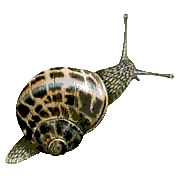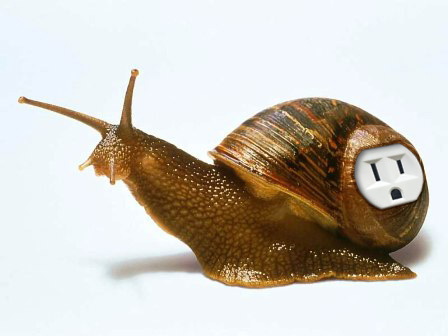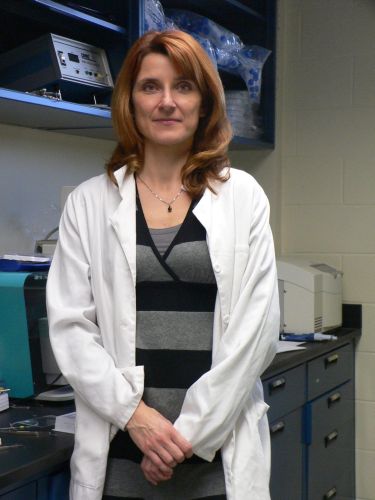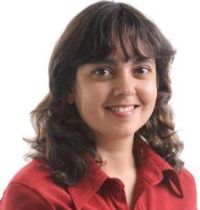| Video
highlights: G4 TV New Scientist Russian TV TV News - YNN - Your News Now Nanotechnology news Israeli TV program |
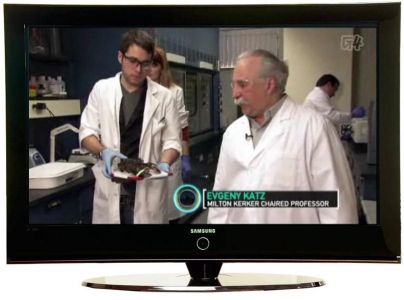 |
Audio
highlights: ACS Podcast German radio Russian radio Israeli radio Big Picture Science |
 |
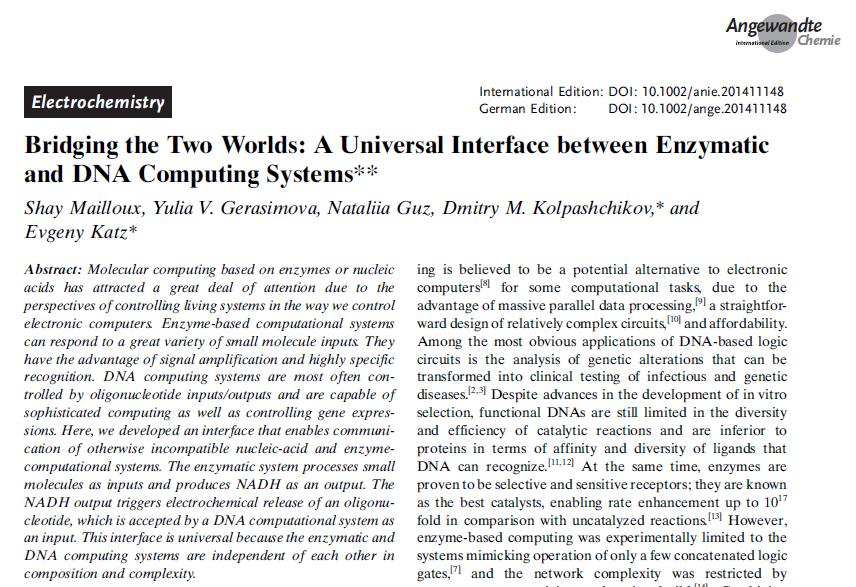 |
12 May 2015 Our paper entitled "Bridging the Two Worlds: A Universal Interface between Enzymatic and DNA Computing Systems" by co-authors: S. Mailloux, Y.V. Gerasimova, N. Guz, D.M. Kolpashchikov, E. Katz was published by Angew. Chem. Int. Ed. and highlighted by Nature Nanotechnology: Molecular computing: A logical connection. |
 |
22 July 2014 The book "Implantable Bioelectronics"
edited by Prof. Katz was highlighted
in the web-site of Kazan University (Russia). One of the chapters in
this book was written by researchers from Kazan University.
|
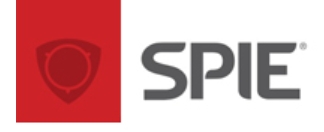 |
28 March 2014
Our research was highlighted in SPIE Newsroom: Boolean logic systems for biochemical analysis. SPIE is an international society
advancing an interdisciplinary approach to the science and application
of light.
|
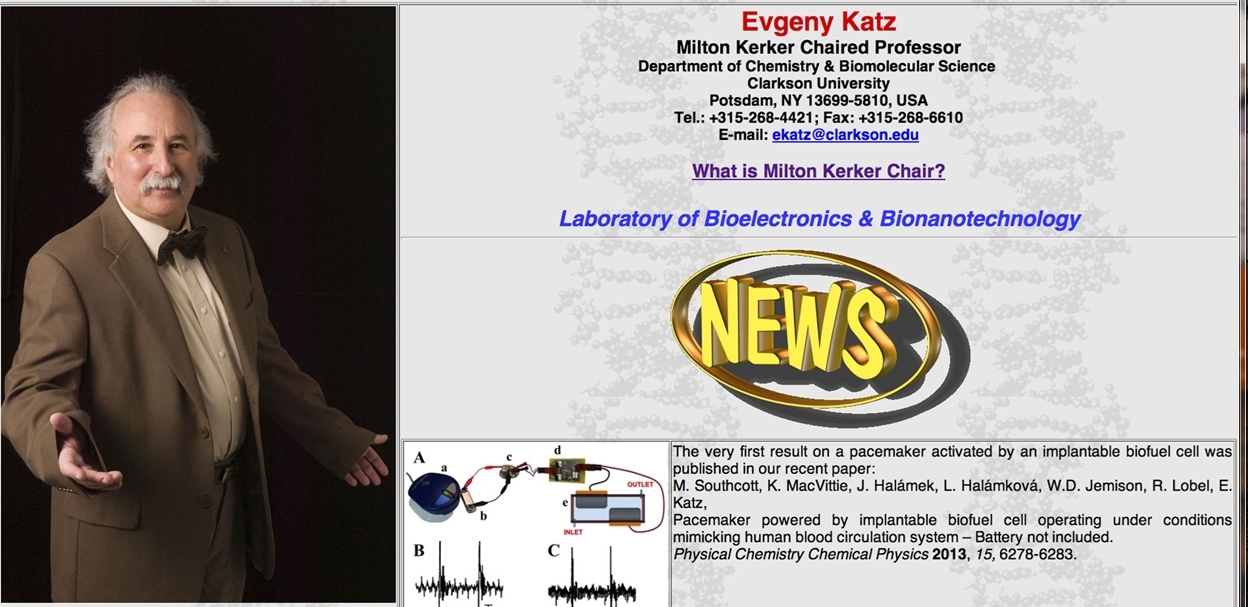 |
21 March 2014
Our group web page was highlighted
by Wired web-magazine (UK): "Look at these
amazing academic pages. Just look at them".
|
|
7 February 2014
 Two our papers
published recently in Analyst
(RSC) have been selected as HOT articles and highlighted by the RSC.
|
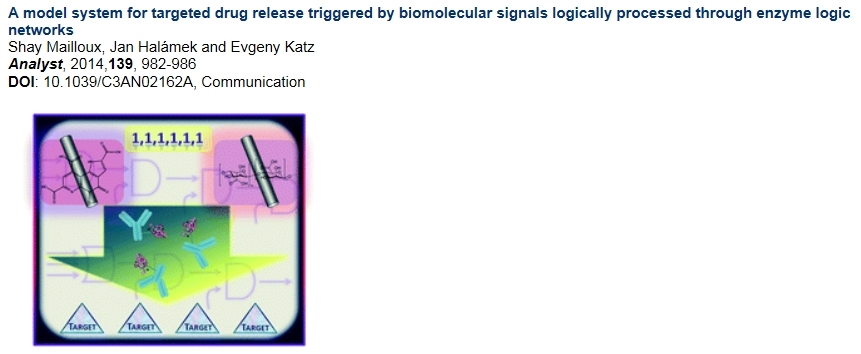 |
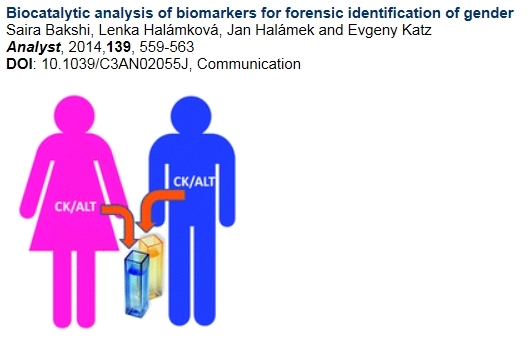 |
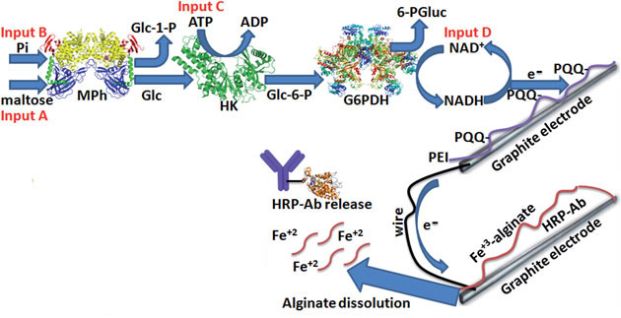 |
23 December 2013 Biocomputer decides when to administer drugs Our research on biomarker-stimulated drug release was highlighted by Chemistry Word (RSC). Experts
in the area explained: A Prasanna de Silva, a molecular
computation expert at Queens University Belfast, UK, describes the
system as a rare example of logical drug release. While, professor in
unconventional computing at the University of the West of England, UK,
Andy Adamatzky says that ‘Katz's lab has opened new application domains
for future and emergent computing paradigms. They transform
unconventional computing from a purely theoretical field to a vibrant
experimental area where concepts of unorthodox information processing
and decision making can be realised with biomolecules and, potentially,
applied to personal illness treatment.’
Another highlight was published by Clarkson's News: Clarkson University Researchers Developing Personalized Medicine. |
| 12 December 2013 Cutting edge chemistry
in 2013
Expert panel of journal editors Chemistry World (RSC) included our work in the list of "ground breaking research": "Another group has developed a bioassay that can be used to analyse blood samples on-site to give investigators an early indication of a suspect’s ethnicity.Evgeny Katz at Clarkson University, US, in collaboration with Jan Halámek, now at the State University of New York at Albany, analysed levels of two biomarkers – creatine kinase and lactate dehydrogenase – in the blood of people of Caucasian and African American ethnicity. They then developed a bioassay to amplify the differences in these levels. The test could successfully distinguish between ethnicities in real human blood samples, as well as samples a day old, as could well be the case at a crime scene." |
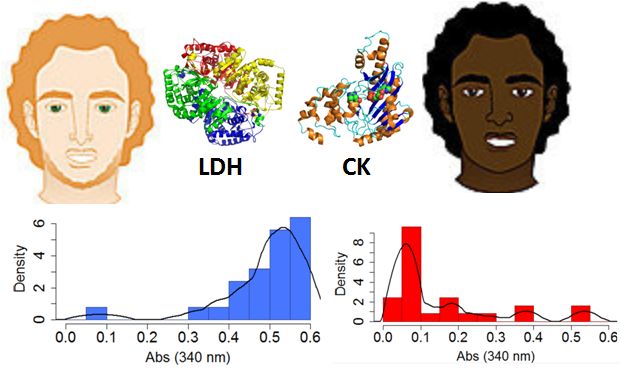 |
October 15, 2013 Our research on
forensic science allowing to recognize ethnicity from biomarker
analysis in blood was highlighted by: Clarkson
News, Chemistry
World (RSC), North
Country Now, Daily
Courier-Observer, Lab
Manager, Watertown
Daily Times, Forensic
Magazine, Bioanalysis-zone,
CAMP
Annual Report,
|
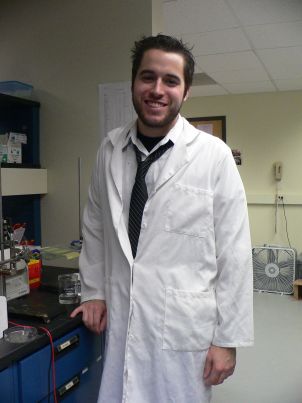 |
February 17, 2013 Big Picture Science radio
featuring Kevin MacVittie,
graduate student of chemistry, Clarkson University, New York, on his
work deriving energy from lobsters.
|
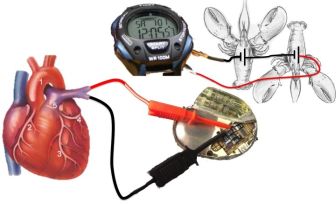 |
October 21, 2012
(continuously updated) Our research on implanted
biofuel cells was extended to biofuel cells implanted in lobsters
connected in serial and used to activated an electronic watch (as a
model device). In another system several fluidic biofuel cells
mimicking human blood circulation system were used to activated a
pacemaker. A new paper was published in Energy
& Environmental Science and highlighted by:
RSC
(Chemistry world blog), RSC
(Publishing Blog), Technology
Review (published by MIT), Technology
Review (German version), ChemEurope.com,
Road
to Abundance, Khaleej
Times,
in Russian: Meandr.org, in German: heise.de, in Dutch: ct.nl, |
 |
April 22, 2012
(continuously updated) Our research on implanted biofuel cells was highlighted by G4 TV channel - see the video clip here: "How To Harvest Electricity From Lobsters". The story was also highlighted in the internet: treehugger.com, EcoFriend, chrisroubis.com, also in Ukrainian: Green Tech, in German: Innovaatio, in Croatian: Vidi, |
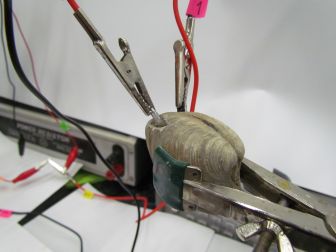 |
April 16, 2012
(continuously updated) Our research on implanted
biofuel cells was extended to assembling individual biofuel cells
implanted in clams in batteries with parallel or serial connections. A
new paper was published in Energy
& Environmental Science and highlighted by:
RSC
(Chemistry world blog), RSC
(Publishing Blog), WebElements
Nexus, Immortality
Medicine, Innovation
News Daily, Live
Science, Mother
Nature Network, Softpedia,
GizmoWatch,
Wetenschapsforum,
Huff
Post Science, gizmodo, smeet.org,
Humanitarian
News, Health
Plaza, Ivar's,
Co.EXIST,
smartplanet.com,
evdl.org,
energydigital,
ubergizmo.com,
ecomagination,
NUB
News, infoniac.ru,
hplusmagazine.com,
Yahoo!
News, topnewstoday,
fastcoexist.com,
|
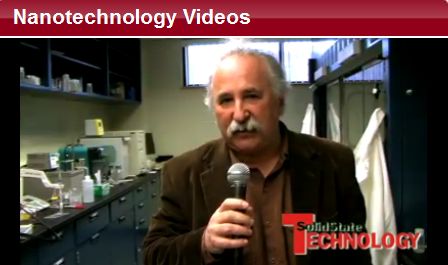 |
April
2011 Nanotechnology news from Pennwell
Publishing has featured research in our group. See a short video
interview on-line (scroll partway down the page, find
Nanotechnology Videos and then scroll down and click on the play button
for the image
similar to shown at the left; the video clip can be watched directly here).
|
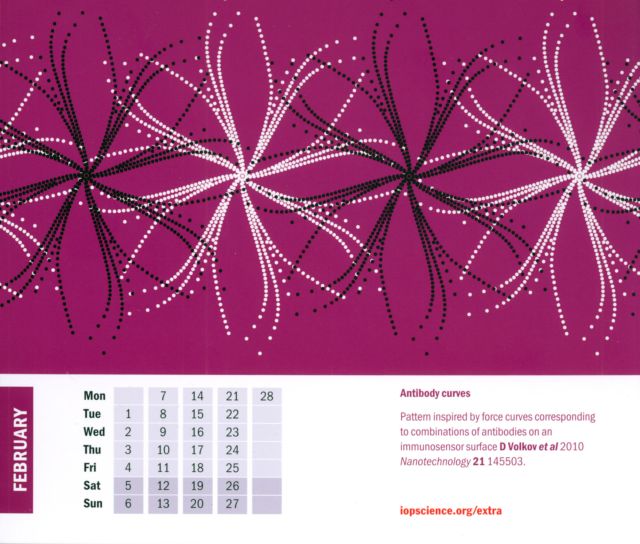 Calendar image inspired by the scientific figure |
 Original figure in the research paper: D.
Volkov, G. Strack, J. Halámek, E. Katz, I. Sokolov, Atomic force microscopy study of
immunosensor surface to increase sensitivity and scale down size of
ELISA-type sensor. Nanotechnology 2010, 21. article # 145503.
|
An image inspired by the
work of Clarkson University researchers is featured on a 2011 calendar
published by the Institute of Physics (IOP). Founded in 1874, IOP is a
worldwide leading communicator and publishing organization with more
than 40,000 members, publishing 60 journals read in more than 180
countries, The graphic for February features a pattern "inspired by
force curves corresponding to combinations of antibodies on an
immunosensor surface." It was motivated by a paper, titled "Atomic
Force Microscopy Study of Immunosensor Surface to Scale Down Size of
ELISA-type Sensor" (Nanotechnology, 2010, volume 21, number 14) and
written by Clarkson University graduate students Dmytro Volkov,
Guinevere Strack, and Jan Halamek (postdoctoral fellow), and Professors
Evgeny Katz, and Igor Sokolov. Katz is the Milton Kerker Chaired
Professor of Colloid Science, and Sokolov is director of the
Nanoengineering and Biotechnology Laboratories Center (NABLAB). The
research was done within the NABLAB Center, a unit established to
promote cross-disciplinary collaborations within the University.
Comprising more than a dozen faculty members, the center capitalizes on
the expertise of Clarkson scholars in the areas of cancer cell
research, fine particles for bio and medical applications, synthesis of
smart materials, advanced biosensors, etc.
|
 Tuesday,
March 1, 2011 - College Notes Tuesday,
March 1, 2011 - College NotesEvgeny Katz was listed by Thomson Reuters in the list of top chemists for the decade 2000-2010. |
|
On February 10, 2011, Thomson Reuters released data identifying the world’s top 100 chemists over the past 10 years as ranked by the impact of their published research. The top 100 is intended to celebrate the achievements of chemists who achieved the highest citation impact scores for chemistry papers (articles and reviews) published since January 2000. Thomson Reuters published the table in support of the International Year of Chemistry. Read the full report below the table. Top 100
Chemists, 2000-2010, Ranked by Citation Impact
Among those with 50 or more papers (fragment of the table)
The United Nations Educational, Scientific and Cultural Organization (UNESCO) and the International Union of Pure and Applied Chemistry (IUPAC) have proclaimed 2011 the International Year of Chemistry. During the year, celebrations and special events will be held around the globe “to increase the public appreciation of chemistry in meeting world needs, to encourage interest in chemistry among young people, and to generate enthusiasm for the creative future of chemistry.” The table above is intended to celebrate the achievements of 100 chemists who achieved the highest citation impact scores for chemistry papers (articles and reviews) published since January 2000. Citation impact (citations per paper) is a weighted measure of influence that seeks to reveal consistently superior performance. To ensure that a high score could not be achieved by a few highly cited papers, a threshold of 50 papers was used in the analysis. The average citation impact in chemistry for the period was 11.07, so all the researchers listed above achieved more than five times that mark. Since approximately a million chemists were recorded in the journal publications indexed by Thomson Reuters during the last decade, these 100 represent the top hundredth of one percent. Sixteen of those listed also ranked in the top 100 by citation impact in materials science, among those who published 25 or more papers in that field during the last decade. Their ranks in materials science [MS] are noted beneath their ranks in chemistry. Nanotechnology in all its aspects is strongly in evidence when one surveys the research interests of the chemists listed. While the rubric covers much, and some skeptics call “nano” the latest fad in chemistry, there is no denying the message of the citation indicators. The field has attracted enormous interest during the last decade. Of the 100, 60 of these chemists identify nanotechnology as their main focus or a significant research topic. The national affiliations of the authors are: 70 for the United States, seven for Germany, four for the United Kingdom, two each for Canada, France, Denmark, Switzerland, and South Korea, and one apiece for Australia, Belgium, Sweden, Italy, Israel, South Africa, Brazil, Japan, and Singapore. The institutions appearing three or more times are: Massachusetts Institute of Technology (6), The Scripps Research Institute (5), University of California Berkeley (5), Harvard University (4), Rice University (4), Northwestern University (4), California Institute of Technology (3), University of California Riverside (3), and University of Chicago (3). To provide a more comprehensive view of high-impact researchers in chemistry, lists of the top 100 researchers in materials science and in biochemistry will appear during the year on ScienceWatch.com. |
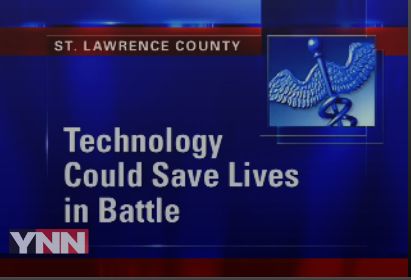 |
TV News - YNN - Your News Now Technology could help wounded service members By: Rachael Paradis It's technology that could save many
lives. And even though it's just in the research phase right now, our
Rachael Paradis tells us more about technology that could provide
medical care to service members injured in the field.
|
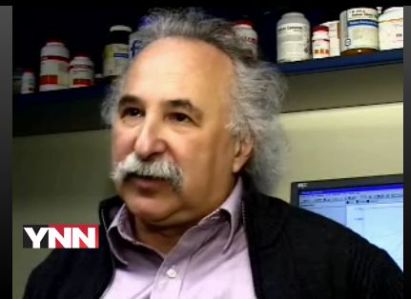 |
POTSDAM, N.Y. -- It's a simple patch
that will be worn at all times by service members and it could be their
safety when in the line of duty. One of the professors leading this research says when the body suffers an injury, certain chemicals are released. This patch would, in turn, release other chemicals or drugs to help treat the service members until more stable care can be reached. "If somebody is injured, there is a big problem to get immediate help, directly on the battle field and we are just looking to create an automatic system," said Evegny Katz, Clarkson University Chemistry Chair. According to Professor Katz, this is just the beginning of research and it will be years until it can be put to use. "There is a big difference between fundamental research in university and final practical evaluation. It will be designed by next step of research," Katz said. There are about 20 people conducting the research, half of which are here at Clarkson. The other half are in California. For research students like Kevin Macvittie, it's a great hands-on opportunity."It's really just an excellent way to prepare for the future. The thing about being able to do research as an undergrad is you get to get a little feeling for what things are like after school," Macvittie said. The research is funded by the Department of Defense and cost about $2 million. They're only about halfway through this research phase. It will last about another two years and after that, it will start to be developed by other engineers. The research team mentioned in California is headed up by Professor Joseph Wang with the University of California in San Diego. |
 11 February 2011 Scientists in the US have made a system
that rapidly detects both explosives and nerve agents, providing a
simple yes-no response. The technique could replace two time-consuming
tests that are currently used to assess these threats. Joseph Wang and colleagues from the
University of California, San Diego, combined their expertise in threat
detection and electrochemical biosensors with the biocomputing
experience of Evgeny Katz from Clarkson University, Potsdam, NY. The
team produced an enzyme-based logic gate with the ability to
simultaneously detect both nitroaromatic explosives and organophosphate
nerve agents. The team fed
2,4,6-trinitrotoluene (TNT) and the nerve agent paraoxon into the
system, in which a series of reactions catalysed by four enzymes takes
place. The products of these reactions deplete hydrogen peroxide, which
is used to indicate the presence of one or both threats. H2O2
levels exceeding a selected threshold indicate 'safe' situations,
while levels below the threshold value signify a 'hazardous'
situation.
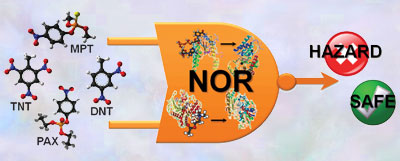 The explosives and
nerve gases are fed through an enzyme-based logic gate system, in which
the depletion of hydrogen peroxide detects their presence. Escalating threats of terrorist activity
have led to urgent demands for innovative devices to provide on-site
detection of chemical and biological agents, as well as explosive
materials. The pressure is therefore on scientists to develop faster,
more reliable and portable sensing technology to detect as many threats
as possible and to alert the operator when a hazard has been
encountered. The ability to
simultaneously measure different types of threats holds considerable
promise for diverse security screening and surveillance applications,'
says Wang. 'The new system is still at an early stage, but the goal is
to provide an early and rapid warning for a potential threat and to
follow this with identification of the specific hazard.' 'This study shows that the interface of
biology and computing delivers a new class of simple, low cost and
reliable analytical devices,' says Lars Angenent, an expert in
bioelectrochemical systems at Cornell University in the US. 'This is
exciting innovative work and I'm looking forward to seeing other
important applications for this technology,' he concludes. The explosives and
nerve gases are fed through an enzyme-based logic gate system, in which
the depletion of hydrogen peroxide detects their presence. Escalating threats of terrorist activity
have led to urgent demands for innovative devices to provide on-site
detection of chemical and biological agents, as well as explosive
materials. The pressure is therefore on scientists to develop faster,
more reliable and portable sensing technology to detect as many threats
as possible and to alert the operator when a hazard has been
encountered. The ability to
simultaneously measure different types of threats holds considerable
promise for diverse security screening and surveillance applications,'
says Wang. 'The new system is still at an early stage, but the goal is
to provide an early and rapid warning for a potential threat and to
follow this with identification of the specific hazard.' 'This study shows that the interface of
biology and computing delivers a new class of simple, low cost and
reliable analytical devices,' says Lars Angenent, an expert in
bioelectrochemical systems at Cornell University in the US. 'This is
exciting innovative work and I'm looking forward to seeing other
important applications for this technology,' he concludes. |
 CLARKSON PROFESSORS: Inclusion
in worldwide ranking considered an honor
By LORI SHULL TIMES STAFF WRITER THURSDAY, JANUARY 13, 2011 POTSDAM — Two Clarkson professors have been ranked among the top chemists in the world. Evgeny Katz, professor of chemistry and biomolecular science, and Egon Matijevic, professor of colloid and surface science, have been placed on the Hirsch index. The list is compiled by the London-based Royal Society of Chemistry, a professional organization for chemical scientists. "It's a pleasure just to see your name on such a list," said Mr. Katz, who is the Milton Kerker-chaired professor of colloid science. "This is about chemists around the globe — Chinese, Russians, Europeans, everyone is there — so to be number 300-and-something is pretty good." Mr. Katz ranks in at 380 among 587 chemists around the globe. Mr. Matijevic is 218, according to the index. Neither is a member of the Royal Society of Chemistry. |
 Thursday, January 13, 2011 POTSDAM
– Clarkson University's Egon Matijevic, the Victor K. LaMer Professor
of Colloid and Surface Science, and Evgeny Katz, the Milton Kerker
Chair in Colloid Science, are listed in the H-index of living
scientists. The H-index
attempts to measure both the scientific productivity and the apparent
scientific impact of a scientist. The index is based on the set of the
scientist's most cited papers and the number of citations that they
have received in other people's publications.
At ranking #218, Matijevic, with an H of 69, has published 69 papers
(among total 575 papers), which have each received at least 69
citations. At ranking #380,
Katz, with an H of 60, has published 60 papers (among more than 300
papers), which have each received at least 60 citations.
It should be noted that this listed of the most-cited chemists totals
only 587 worldwide with the two Clarkson's professors among them.
The index was suggested by physicist Jorge E. Hirsch as a tool for
determining quality of scientific publications of a person and is
sometimes called the Hirsch index or Hirsch number.
The purpose of this index is similar to the popular impact factor,
which is used to rank the quality of scientific journals, but it is
applied to a person. The definition of the H-index and the explanations
of its importance can be found at http://en.wikipedia.org/wiki/H-index .
The latest list, compiled by Henry Schaefer of the University of
Georgia, together with colleague Amy Peterson, was updated in November
2010 and can be found at
http://www.rsc.org/images/H-index%20ranking%20of%20living%20chemists(March%202011)_tcm18-85867.pdf
|
|
Wednesday, December 22,
2010 POTSDAM A
paper published in the leading journal ChemPhysChem by Evgeny Katz of
Clarkson University and two coauthors has been cited more than 1,000
times, Clarkson says. Katz
coauthored "Nanoparticle Arrays on Surfaces for Electronic, Optical,
and Sensor Applications" with Andrew N. Shipway and Itamar Willner in
2000. The paper has continued
to be one of the most accessed papers in the journal for the past 10
years, when the journal was first published.
ChemPhysChem is a prestigious journal published by Royal Society of
Chemistry, the leading organization in Europe for advancing the
chemical sciences.
|
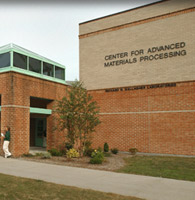 |
Clarkson University, Center for Advanced Materials Processing (CAMP) |
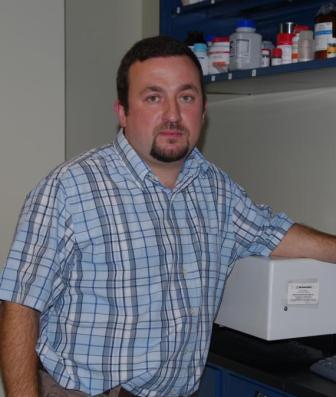 Research Assistant
Professor
Dr. Jan Halámek
|
CAMP ANNUAL REPORT
2009-2010 pages 7-8 With the aim of improving the survival
rate of injured soldiers, a team working at Clarkson University is
designing a biocomputing system that is capable of diagnosing multiple
injuries upon analysis of a complex combination of various biomarkers.
The goals of the present research are to design, optimize, and
critically evaluate a multi-enzyme system composed of concatenated
enzyme-based logic gates which are capable of performing Boolean logic
operations. This system will be applied to the automated processing of
biochemical/physiological information and interfaced with electronic
transducers and signal-responsive drug-delivery materials or actuators.
By employing multiple clinically-relevant injury/trauma biomarkers as
inputs for the enzyme gates, the new biochemical logic system would
provide high-fidelity diagnostics much better than conventional single
biomarker sensors. Recent work of a team of students headed by Research
Assistant Professor Dr. Jan Halámek resulted in the formulation
of a novel approach to the biomedical logic systems. A modular system
comprising six logic gates was prototyped whose outputs were
multiplexed into one concise injury code that could identify 64 unique
injury conditions among 4096 possible physiological scenarios. This innovative paradigm would enable
injury gates to be interchanged as needed for different battlefield
conditions. It represents a substantial development in the
bioprocessing capabilities of the biocomputing logic gate systems. The
results have been published (Analyst 2010, vol.135, pages 2249-2259)
and highlighted at the website of the Royal Society of Chemistry (UK):
http://www.rsc.org/Publishing/Journals/cb/Volume/2010/09/logical_injury_assessment.asp. Dr.
Halámek has been invited with a plenary lecture to the 2010
International Symposium on Spectral Sensing Research at Fort Leonard
Wood, MO, to describe the results of the study. The innovative research
is conducted within the framework of the project supported by a
multi-million dollar award from the Office of Naval Research.
This work is being carried out under the general supervision of
Professor Evgeny Katz as part of a CAMP program at Clarkson University.
|
 Research Assistant Professor Dr. Vera Bocharova |
CAMP ANNUAL REPORT
2009-2010 page 8 A
novel switchable biocatalytic interface has been designed by a team of
students headed by Research Assistant Professor Dr. Vera Bocharova. A
nanostructured biocatalytic interface reversibly gating electrochemical
reactions upon chemical signals processed by immobilized enzymes was a
goal of the project. The chemical signals were converted to local
interfacial pH changes causing restructuring of the stimuli-responsive
polymer and switching ON–OFF the electrochemical reaction. The
switchable interface represents the first example of a fully functional
integrated nanostructured system composed of the biocatalytic entities
transducing the chemical signals into pH changes and the gating polymer
responding to the local pH value by its restructuring. The results of
the work were published in a prestigious international journal (Chem.
Commun. 2010, vol. 46, pages 2088-2090). The present result opens the
way to enzymatically controlled biochemical interfaces for various
biotechnological applications. The system complexity could be scaled up
to a multi-enzyme ensemble processing many biochemical signals and
resulting in future implantable bioelectronic devices with interfaces
controlled by physiological concentrations of biochemicals. The team
(advised by Dr. Bocharova) continues the work to apply the developed
approach for drug release controlled by external biochemical signals.
This project is one of the most important directions being taken within
the framework of the multi-million dollar program sponsored by the
Office of Naval Research. The research is being performed under
the
general supervision of Professor Evgeny Katz as part of a CAMP program
at Clarkson University.
|
 The
cartoon shows schematically the switchable biofuel cell controlled by
pH changes produced in situ by the enzyme logic systems processing
biochemical inputs.
|
June 2010 CAMP June Newsletter: Page 4 Biofuel
cells with switchable power release, controlled by biochemical signals
logically processed by biomolecular computing systems, have been
designed by Professor Evgeny Katz and his group. The switchable
properties of the biofuel cells are based on the polymer-brush-modified
electrodes, with the activity dependent on the solution's pH value. The
pH changes generated in situ by biocatalytic reactions allowed the
reversible activation - inactivation of the bioelectrocatalytic
interfaces, thus affecting the activity of the entire biofuel cells.
Boolean logic operations performed by either enzymes-or immune-based
systems were functionally integrated with the switchable biocatalytic
process, allowing for logic control over them. Scaling up the
complexity of the biocomputing systems to complex multi-component logic
networks (with a built-in "program") resulted in the control of the
bioelectronic systems by multi-signal patterns of biochemical inputs.
Future implantable biofuel cells, producing electrical power on-demand,
depending on physiological conditions are feasible as the result of the
present research. This work represents novel fundamental results in the
area of renewable and non-conventional energy systems. The studied
biofuel cells exemplify a new kind of bioelectronic devices where the
electrical power production is controlled by a biocomputing system.
Such devices will provide a new dimension in bioelectronics and
biocomputing, benefiting from the integration of both concepts.
|
 DAILY COURIER-OBSERVER - Friday, June 25, 2010 - page 3 DAILY COURIER-OBSERVER - Friday, June 25, 2010 - page 3Biomarkers Could Save Soldiers |
  12 July 2010 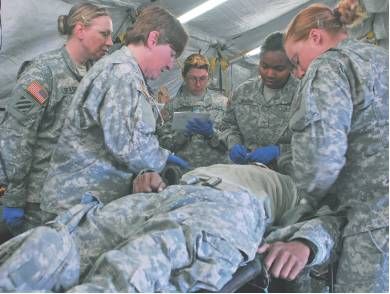 With the aim of
improving the
survival rate of injured soldiers, US Scientists have designed a
biocomputing system that is capable of diagnosing multiple injuries
from a sample of urine or blood.
Explosions on battlefields can result in patients with multiple
injuries that need quick diagnosis. Currently, this is done by physical
examination and a comprehensive series of laboratory tests in hospital.
When an organ is injured, the body releases chemicals that can be used
as biomarkers to indicate particular internal injuries. Multiple
injuries release a wide range of biomarkers and now a team led by
Evgeny Katz from Clarkson University, and Joseph Wang at the University
of California San Diego, have developed a diagnostic tool that can be
used in the field and is able to differentiate between many chemical
inputs to provide a diagnosis. The
system comprises six logic gates made from enzymes that are sensitive
to twelve biomarker inputs associated with six different pathological
conditions, including soft tissue injury, abdominal trauma and brain
injury. The enzyme gates each produce a logic output (1 or 0), which
together form a 6-bit 'injury code', that allows full diagnosis of the
patient's condition. Katz says
the use of biocomputing, or biomolecular chemical reactions, instead of
electronic computers, simplifies the analysis so it can be performed in
field conditions. He adds that 'this is the first fundamental result
for the use of biocomputing systems for biomedical applications.' AP
de Silva, an expert in molecular sensor technology at Queen's
University Belfast in the UK, comments, 'multiplexing several enzyme
gates to develop injury codes builds on previous applications of
molecular logic in diagnosing electrolyte abnormalities and TB
infection.' The team now
intends to develop their work further for other biomedical applications
and hope to develop on-body sensors. With the aim of
improving the
survival rate of injured soldiers, US Scientists have designed a
biocomputing system that is capable of diagnosing multiple injuries
from a sample of urine or blood.
Explosions on battlefields can result in patients with multiple
injuries that need quick diagnosis. Currently, this is done by physical
examination and a comprehensive series of laboratory tests in hospital.
When an organ is injured, the body releases chemicals that can be used
as biomarkers to indicate particular internal injuries. Multiple
injuries release a wide range of biomarkers and now a team led by
Evgeny Katz from Clarkson University, and Joseph Wang at the University
of California San Diego, have developed a diagnostic tool that can be
used in the field and is able to differentiate between many chemical
inputs to provide a diagnosis. The
system comprises six logic gates made from enzymes that are sensitive
to twelve biomarker inputs associated with six different pathological
conditions, including soft tissue injury, abdominal trauma and brain
injury. The enzyme gates each produce a logic output (1 or 0), which
together form a 6-bit 'injury code', that allows full diagnosis of the
patient's condition. Katz says
the use of biocomputing, or biomolecular chemical reactions, instead of
electronic computers, simplifies the analysis so it can be performed in
field conditions. He adds that 'this is the first fundamental result
for the use of biocomputing systems for biomedical applications.' AP
de Silva, an expert in molecular sensor technology at Queen's
University Belfast in the UK, comments, 'multiplexing several enzyme
gates to develop injury codes builds on previous applications of
molecular logic in diagnosing electrolyte abnormalities and TB
infection.' The team now
intends to develop their work further for other biomedical applications
and hope to develop on-body sensors.The electronic issue: August 2010 / Volume 5 / Issue 8 |
 |
January 13, 2010 Researchers from Clarkson University report details of new studies and findings in the area of biosensors and bioelectronics According to a study from the United States, "Electrode-immobilized glucose-6-phosphate dehydrogenase is used to catalyze an enzymatic reaction which carries out the AND logic gate." "This logic function is considered here in the context of biocatalytic processes utilized for the biocomputing applications for ''digital'' (threshold) sensing/actuation. We outline the response functions desirable for such applications and report the first experimental realization of a sigmoid-shape response in one of the inputs," wrote V. Privman and colleagues, Clarkson University. |
 Tuesday, November 4, 2008 By Lauren Gravitz The majority of deaths on the battlefield
occur within half an hour after injury--often too quickly for a soldier
to get to a medic, let alone a hospital. But a collaboration between
researchers at the University of California, San Diego (UCSD), and
Clarkson University, in New York, aims to change all that with a chip
that could detect injuries and treat them almost instantly. At the center of the research is a
sensor, still in development, that could be used to continuously
monitor a soldier's blood, sweat, or even tears for biomarkers. All of
these fluids contain glucose, oxygen, lactase, and the hormone
norepinephrine, which fluctuate depending on a person's health and
activity levels. Specific, collective changes in these markers can
indicate the presence of an injury. And once the sensor picks that up,
it could transmit the information elsewhere on the chip, or to another
chip, and trigger release of an appropriate medication. That, at least,
is the idea; the reality, however, could take a little while to
develop. The head of the
project, Joseph Wang, is a nanoengineering professor at UCSD whose
office is packed with electronic sensors of every shape but only two
sizes: small and even smaller. Wang, who previously helped develop a
noninvasive glucose monitor that samples sweat, is no stranger to
continuous sensing. But rather than picking up just one signal, the new
sensor will need to differentiate among multiple markers and interpret
the results. To do this, Wang
is collaborating with Clarkson's Evgeny Katz, who recently created a
system that uses an enzyme-based logic gate to not only measure a
combination of biomarkers but also use the results to make a limited
diagnosis. Katz's system is based on enzyme-driven reactions: in the
presence of certain enzymatic products, one set of "gates" is unlocked
and triggers a specific chain reaction; other products trigger a
completely different set of gates. The end result is a logic chain that
has the potential to identify certain medical conditions. So far, Katz's enzyme logic diagnostics
work only in solution. But Wang and Katz envision a system that would
use an electronic sensor, one containing enzymes, to detect the
presence or absence of the four biomarkers mentioned above: glucose,
oxygen, lactase, and norepinephrine. In different combinations, these
biomarkers can indicate different injuries, such as brain trauma or
shock. Depending on the injury, the electrodes would translate the
enzymatic results into a code that activates signal-dependent membranes
to release the appropriate medication. If a soldier were to go into
hemorrhagic shock, for example, the electrode would detect rising
levels of lactate, glucose, and norepinephrine. As the electrode
enzymes' product mixture begins to change, the reaction would trigger
the logic gate unique to shock and, potentially, signal for the release
of the appropriate medication. "We want to build a smart, intelligent
sensor that can distinguish between different injuries, make the
decision to treat, and, once it recognizes the injury, treat
appropriately," Wang says.
|
 By ALEX JACOBS TIMES STAFF WRITER WEDNESDAY, OCTOBER 29, 2008 POTSDAM
— Clarkson University is a joint recipient of two grants totaling $3
million to advance research into sensor technology, which professors
say could be the next frontier of science.
Clarkson
announced Tuesday that one of its professors will be a co-principal
investigator on a $1.6 million joint grant project with the University
of California-San Diego. Evgeny Katz, the college's Milton Kerker
chaired professor, hopes to develop a "field hospital on a chip" that
could save soldiers' lives on the battlefield.
Using biocomputing and enzymes, he is creating an automated
sense-and-treat system that could continuously monitor the wearer's
blood, sweat or tears for markers that signal common injuries such as
trauma, shock, brain injury or fatigue.
"For example, if the soldier has a small oxygen concentration and high
adrenaline, we'll know they're under stress and probably very wounded,"
he said. The ultimate goal is
for the biological sensor to detect an illness and then administer the
proper medication immediately, helping to speed recovery before a
soldier even reaches a field hospital, Mr. Katz said.
"It means the soldier will get immediate medical treatment in the few
minutes after they are wounded, even before they are evacuated to
hospital. It could save his life maybe for these critical minutes," Mr.
Katz said. UC San Diego
Professor Joseph Wang is also a co-principal investigator for the
project. At Clarkson, the funding will back two postdoctoral
researchers and one graduate student to help with the study, as well as
the cost of expensive biochemicals.
Thanks to a $1.4 million National Science Foundation grant announced
last week, Clarkson also will soon expand a high school science,
technology, engineering and math curriculum that it created along with
the Beacon Institute for Rivers and Estuaries. The
two institutions hope to teach 9,000 students to build, test and deploy
sensors to monitor water quality in the Hudson and St. Lawrence rivers.
"Sensors are also going to shift paradigms in how we investigate
things. We're going to need a new work force — just like we needed
computer and Internet people — to accommodate that," said James S.
Bonner, director of Clarkson's Center for the Environment and research
director for the Beacon Institute.
Through the Student Enabled Network of Sensors for the Environment
using Innovative Technology program, high school science teachers from
St. Lawrence, Jefferson, Franklin and Dutchess counties, as well as the
city of Troy, will receive training. SENSE IT lessons will include both
in-class and out-of-school programming.
"They say the 1980s was the decade of the personal computer, and the
1990s was the decade of the Internet. Now we're coming into the decade
of the sensor," said Susan E. Powers, associate dean for research and
graduate studies at Clarkson's Coulter School of Engineering. "The idea
with sensors is that we can do this, provide a real-time understanding
of what the water quality looks like in these great rivers, and better
prepare students for the technologies they're going to be faced with in
the near term."
|
Nov 29 2008 In the battlefield of the future, soldiers
with traumatic injuries may get treatment before even reaching a medic.
Scientists at several universities are creating what is called a “field
hospital” on a microchip. This microchip could be worn by almost any
soldier. It would allow the immediate detection of a traumatic injury
and then could administer medication simultaneously. Most battle wounds
require treatment within the first 30 minutes. Two researchers, Joseph
Wang from University of California and Evgeny
Katz of Clarkson University are getting a 1.6 million dollar
grant coming from the Office of Naval Research. They will use the money
to create a high-tech field hospital on a chip. The
chip itself will be automated and will be able to continuously monitor
several biomarkers coming from a soldier. It will test the sweat and
blood for common indicators of battlefield injuries. It will also be
able to diagnose traumatic brain injuries and can adjust the necessary
medication dose. This may go a long way in reducing brain
injuries sustained from an insult.
|
 The
battlefield of the future may react differently to combat injuries,
providing instant treatment to wounded soldiers even before a medic
reaches their side. Impossible? Not if researchers at universities on
opposite sides of the country succeed in creating a "field hospital on
a chip" - a system worn by every soldier that would detect an injury
and automatically administer the right medication. Survival of
battlefield wounds often depends on the level of treatment within the
first 30 minutes. Evgeny Katz of Clarkson University in Potsdam, N.Y.,
and Joseph Wang of the University of California, San Diego, will share
a four-year, $1.6 million grant from the Office of Naval Research to
create the high-tech field hospital. The automated sense-and-treat
system will continuously monitor a soldier's sweat, tears or blood for
biomarkers that signal common battlefield injuries such as trauma,
shock, brain injury or fatigue and then automatically administer the
proper medication. Katz will lead a team of researchers who are working
on creating enzymes that can measure the biomarkers and provide the
logic necessary to make a limited set of diagnoses based on several
biological variables. "We have already designed bioelectrodes and
biofuel cells responding to multiple biochemical signals in a logic
way," says Katz, co-principal investigator on the project. "In the
future we could expect implantable devices controlled by physiological
signals and responding to the needs of an organism, notably a human."
Katz, who joined the Clarkson faculty two years ago from the Hebrew
University of Jerusalem, holds the Milton Kerker Endowed Chair of
Colloid Science at Clarkson. His current research is a continuation of
work begun before joining the Clarkson faculty. Wang, principal
investigator on the project, will head a nanoengineering team in San
Diego that will build a minimally invasive system for the soldier's
body to process the biomarker information, develop a diagnosis and
begin administering the proper medications. "Since the majority of
battlefield deaths occur within the first 30 minutes after injury,
rapid diagnosis and treatment are crucial for enhancing the survival
rate of injured soldiers," says Wang. Wang and Katz hope that the
resulting enzyme-logic sense-and-treat system will revolutionize the
monitoring and treatment of injured soldiers and will lead to dramatic
improvements in their survival rate.
|
 Summary of Current Research Cutting-edge research is currently being
conducted at the Department of Chemistry and Biomolecular Science and
NanoBio Laboratory, Clarkson University (Potsdam, NY) to integrate
biofuel cells with biocomputing systems. The talented team of
postdoctoral researchers and graduate students headed by Prof. Evgeny
Katz at Clarkson has designed biofuel cells with a switchable power
release controlled by biochemical signals that are logically processed
by biomolecular computing systems. The switchable properties of the
biofuel cells were based on polymer-modified electrodes, and their
activity depends upon the pH value of the surrounding solution. At a
certain pH value, the polymer swells to open the electrode surface for
electrochemical reactions, while another pH value causes the polymer to
shrink, thus closing the electrode interface and inhibiting
electrochemical processes on it. The pH changes generated in situ by
biocatalytic reactions allowed the reversible activation–inactivation
of the bioelectrocatalytic interfaces, thus affecting the activity of
the biofuel cell as a whole. Boolean logic operations performed by
either enzymes- or immuno-based systems were functionally integrated
with the switchable biocatalytic process, thereby allowing logic
control over them. Scaling up the complexity of the biocomputing
systems to complex multi-component logic networks with a built-in
“program” resulted in the control of the bioelectronic systems by
multi-signal patterns of biochemical inputs. The studied biofuel cells
demonstrated for the first time the possibility to control power
release by biochemical signals processed according to the Boolean logic
operations “programmed” into the biocomputing systems. Specific
pathophysiological conditions, such as injuries, can activate the
“programmed” implanted biofuel cell using the produced power for drug
release.
Future Developments The present research paves the way for the
future development of implantable biofuel cells that produce on-demand
electrical power depending on physiological conditions. This opens
opportunities for future implantable bioelectronic devices that will be
logically controlled by physiological conditions, including various
biomarkers, substrates and immuno-signals. Patients with unstable
rapidly changing physiological conditions will receive the
automatically adjusted power release from the implanted biofuel cell.
The systems designed and the experiments performed demonstrate the
concepts and illustrate possible approaches to resolving these issues,
highlighting many possible directions for further research. The
complexity of the biocomputing system that controls the biofuel cell
should be increased to achieve a complex
multi-component/multi-functional logic network. This network will
provide efficient processing of multi-signal information from the human
body to adjust the power release from the implanted biofuel cell
accordingly. Further development of sophisticated enzyme-based
biocomputing networks will be an important phase in the development of
“smart” bioelectronic devices. Scaling up the complexity of the
biocomputing system that controls biofuel cell activity will be
achieved by networking immuno- and enzyme-based logic gates responding
to a large variety of biochemical signals.
|
|
March 25, 2008 Molecular Computation Carmen Drah lA security-type control system with
a password made up of enzymes rather than numbers or letters has been
devised by Evgeny Katz and coworkers at Clarkson University in Potsdam,
N.Y. This type of biochemical network, which mimics an electronic
keypad lock, could one day be used to control implantable medical
devices based on individual body chemistry (J. Am. Chem. Soc., DOI:
10.1021/ja7114713).
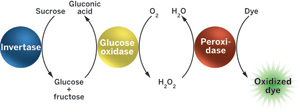 CODE An enzyme-based security-type keypad begins with a solution of sucrose, a dye, and oxygen. The password consists of three enzymes (blue, yellow, and red) that must be added to the solution in the right order. The correct combination oxidizes the dye to a colored product, a measurable output. Another research group has already made this type of chemical device from a pathway that manipulates synthetic fluorophores (J. Am. Chem. Soc. 2007, 129, 347). However, the new system is made from biochemical components, so it "offers advantages in terms of biocompatibility," says molecular electronics expert Devens Gust of Arizona State University. It is also highly adaptable; enzymes or substrates can be changed for different applications, Katz tells C&EN. To demonstrate the system, Katz's team developed a sucrose solution containing a dye that would yield a colored output after a sequence of three enzymes is added to it. The first enzyme, invertase, hydrolyzes sucrose to glucose and fructose. The next enzyme oxidizes glucose while reducing oxygen to hydrogen peroxide. Finally, a peroxidase uses hydrogen peroxide to oxidize the dye to a measurable colored product. No colored product is formed unless all three enzymes are added in the correct order. It's too early to know whether this type of enzyme network may be used for making molecular-level decisions in the body, such as releasing a drug in response to a specific sequence of biochemical events, Katz says. For now, the team is working on reconfiguring enzyme networks to process biochemical information in different ways. |
 ScienceDaily (Mar. 25, 2008) —
Researchers in New York are reporting an
advance toward a new generation of ultra-powerful computers built from
DNA and enzymes, rather than transistors, silicon chips, and plastic. A
new report on the development of a key component for these
"biomolecular computers" has just been published.
Evgeny Katz and colleagues
describe development of a chemical "keypad lock," one of the first
chemical-based security systems of its kind. The researchers note that
years of effort have gone into developing biomolecular computers, which
rely on chemical reactions rather than silicon chips to perform logic
functions. Among their uses would be encryption of financial, military,
and other confidential information. Only individuals with access to a
secret "key" -- a chemical key -- could unlock the file and access the
data.
The research by Katz and
colleagues solved one part of this technological challenge: The
security code. They identified a series of naturally occurring chemical
reactions that act as a "keypad lock." In laboratory studies, they
demonstrated that by adding the correct series of chemicals, the lock
could be opened to access the computer. On the other hand, adding the
incorrect chemicals to the system acts as a wrong password and prevents
access to the computer, they say. "In addition to the
biomolecular security applications, the enzyme-based implication logic
networks will be extremely important for making autonomous decisions on
the use of specific tools/drugs in various implantable medical systems."
|
 Clarkson University, Center for Advanced Materials Processing (CAMP) CAMP NEWSLETTER Volume 23, No. 3, March 2008 Professor Evgeny Katz Initiates Novel Biocomputing Project |
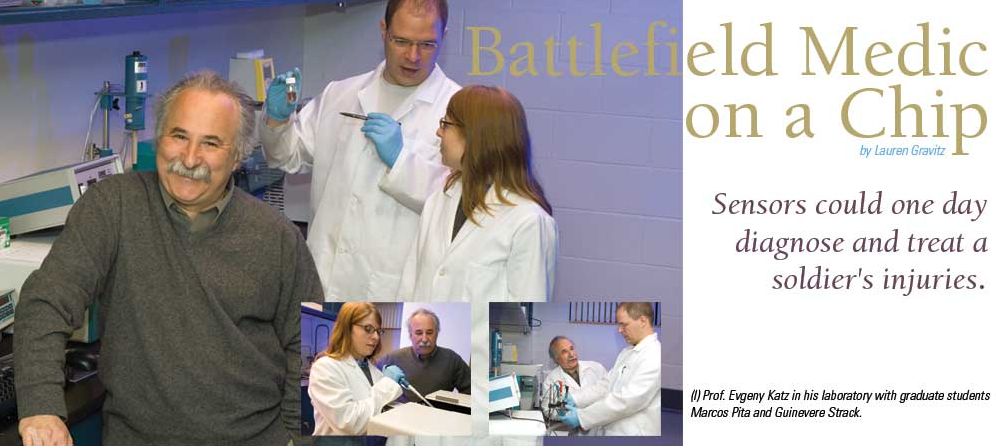 Clarkson Magazine, 2008 President's Report, pages 16-18 Battlefield Medic on a Chip - Sensors could one day diagnose and treat soldier's injuries |
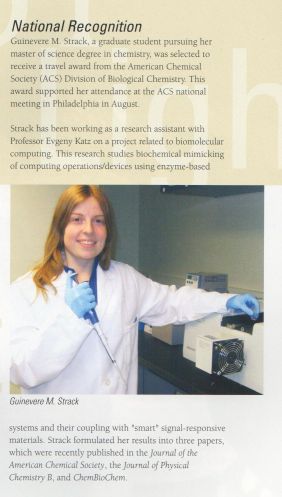 Clarkson Magazine, Vol. MMVIII, No. 2, Fall 2008, page 3 National Recognition - PhD student in the group of Prof. Evgeny Katz received an award. |
 Advance News, St Lawrence County
Newspapers, Sunday, March 23, 2008 Advance News, St Lawrence County
Newspapers, Sunday, March 23, 2008Clarkson 'Key Pad' Biomolecular Computer Research In Spotlight |
 CAMP June Newsletter:
June 2008, Page 5 CAMP June Newsletter:
June 2008, Page 5Professor Evgeny Katz’s Biocomputing Projects Achieve their Goals Professor Evgeny Katz and his group
achieve the goals of their biocomputing projects. From left in back
row: Dr. Marcos Pita, graduate student Melina Kraemer, Professor
Evgeny Katz, and graduate student Guinevere Strack. From left in
front row: Graduate students Tam Tsz Kin and Zhou Jean.
The novel biocomputing projects, initiated
by Professor Evgeny Katz (the Milton Kerker Chaired Professor in
Colloid Science at Clarkson University) and his group, are achieving
their goals. In March the group proudly reported that biomolecular
systems could perform logic operations mimicking electronic logic
gates, like those used in keypad lock security systems. Professor Katz
and his group have also been collaborating with Professor Sergiy Minko.
A result of this joint effort is the use of enzymatic logic operations
to control different responsive materials such as polymeric membranes,
brushes, and colloidal suspensions. Furthermore, these controlled
materials can be deposited on an electroactive surface. This is carried
out by controlling the swollen and shrunken states of these materials
using the logic operation to switch their electrochemical properties on
and off. In addition, Professor Katz’s group collaborated with
Professor Vladimir Privman. This work yielded a very interesting
theoretical analysis of the electronics mimicked with the biological
systems. The biocomputing research being carried out at Clarkson is
currently supported by two NSF-sponsored grants. This
multi-disciplinary research in biocomputing includes the collaborative
efforts of several groups led by Professors Katz, Minko, Privman, and
Sokolov. Results of this work have already been published in high
ranking journals, such as Journal of the American Chemical Society,
Journal of Physical Chemistry C, ChemBioChem and Electroanalysis.
|

Updated on November 30, 2014
